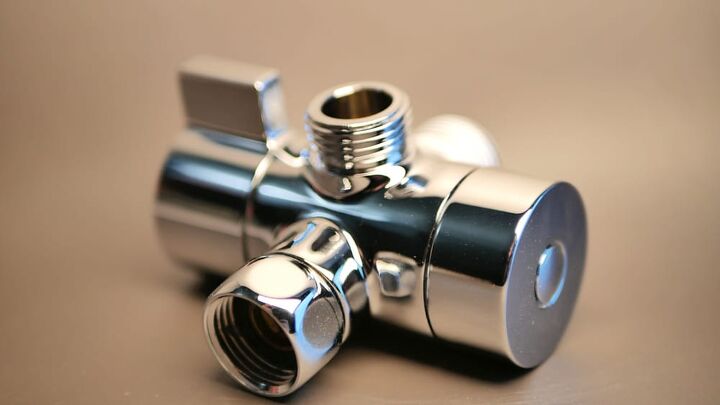How To Fix A Shower Diverter Gate (Step-by-Step Guide)

In plumbing terms, a shower diverter is a term for the valve that redirects water from the showerhead to the bathtub faucet. If you have a bathtub, you most definitely have a shower diverter installed. Even if you don’t have one, you still probably have a diverter installed with your shower fixture.
What if your shower diverter jams up or starts making creaky, grinding noises? Don’t worry; we’ve got you covered. You can try your hand at repairing it via some quick hacks, and if that doesn’t work, you can always replace it.
Repairing and replacing it involves pretty much the same steps. To start, you must dismantle the spout and the diverter. Fixing it will include replacing the rubber washer inside the diverter. While replacement means you’ll have to buy a new valve.
Shower valves have two components, a tub spout and a diverter valve. The spout is where the water comes out of. The diverter switches the water from the tub to the showerhead or vice versa.
Shower diverters can maximize shower space for you. They help clear up room for you in the shower area. You won’t need a separate shower enclosure away from the bathtub, nor will you need different piping for each fixture. This can be particularly helpful if you are short of space and have a compact bathroom.
Let us jump into how we should deal with a faulty shower diverter gate.
Do You Need Tub Liner or Shower Surround Installation or Replacement?
Get free, zero-commitment quotes from pro contractors near you.

Repairing The Shower Diverter
If you don’t want to bear the cost of replacing the shower diverter, you can repair it. You can muster some courage and try doing it yourself!
Let’s see how we repair a faulty shower diverter valve:
Preliminary Steps
Place a towel over the drain to prevent any loose screws and parts from falling into the drain. Turn off the water supply from the main supply line.
Step 1: Unscrewing The Spout
Locate the setscrew; it will be at the bottom of the faucet close to the wall. Use a hex key to loosen the setscrew. If there is no setscrew, use a heavy-duty screwdriver to pry open the spout.
Step 2: Replacing The Washer
Remove the rubber washer from the diverter and replace it with a new washer. Apply lubricant to the threads. Check the circular seat where the rubber washer rests on to see if it is smooth. If it is pitted, replace it.
Step 3: Refitting The Spout
Reinstall the diverter stem, handle, and tube. Fasten all the screws. Test the shower to see if water leaks around the handles.
Replacing A Shower Diverter
A faulty shower diverter reduces the water flowing into the shower and is beyond repair. That is one sign your diverter needs replacement. How do we do that?
Let us explain
Preliminary Step
Place a towel over the drain to prevent any loose bits from falling inside.
Step 1: Removing The Spout
Locate the setscrew below the spout and unscrew it. Pry open the spout if there is no setscrew.
Step 2: Sealing The Supply Line
Use a rag to wipe the diverter and the threads of the pipe. Apply seal tape thoroughly to the threads. Seal the supply line with silicone caulk.
Step 3: Installing The New Spout
Install the new spout onto the supply line and secure the setscrew. Screw it on and slide it onto the tube. Use masking tape to wrap the teeth on the tongue and groove joint.
Step 4: Testing The New Spout
Tighten the spout onto the pipe, be careful not to overtighten it. Test it to see if it is fixed correctly, and no water is leaking.
Cleaning The Spout
The diverter gate can sometimes get stuck because of accumulated dirt, soap, limescale, or grease. In that case, it would be tough to move around, and you will hear squeaky noises when you attempt to turn it.
We’ve got an easy fix for you:
Step 1: Apply White Vinegar
Take some white vinegar from your kitchen. The vinegar needs to be in enough quantity to submerge the spout.
Step 2: Keep The Spout Submerged For A Few Days
Pour it into a plastic; you can mix some water into it if you like. Take the plastic bag and wrap it around the spout. Secure it in place with a rubber band. Keep the spout submerged in the vinegar for three to four days. Once the spout looks clean, pull the diverter to check if it works.
Vinegar is an excellent environment-friendly option compared to bathroom cleaners because it is organic. You do not have to worry about noxious fumes or wearing gloves or masks.
Loosening the Diverter With Cooking Spray
If the vinegar option does not bring your diverter loose, you can dive back into the kitchen for a quick hack! Cooking sprays are good lubricants, and they will loosen stubborn shower diverter gates and knobs.
Step 1: Spray Cooking Spray
Move the diverter knob up and down to loosen it. Spray the cooking spray onto the knob thoroughly.
Step 2: Clean The Diverter
Try moving the knob to see if it moves. Respray a few more times if you need to. Wipe away the spray and wash off any oil from the fixture and the bathtub. Do not use hairspray or wax. These substances are corrosive and will damage your fixture.
Are you looking to retile your shower floor? Click here to get more information about the process.
Soaking The Spout
This method involves a rehash of the vinegar method; only this time, you will drench the insides of the fixture with vinegar.
Step 1: Remove The Spout
For this, you will need to turn off the water supply from the mains supply line. Remove the spout from the wall.
Step 2: Clean The Spout
Use a rasp or sandpaper to clean off any dirt. You can use a paste of vinegar and baking soda for this and leave it on for half an hour.
Step 3: Keep It For A Few Days And Clean It Afterwards
For A Few DaysMix up vinegar and water in a dish. Leave the spout in the vinegar mixture for three to four days.
After that, remove any loose dirt with a rag and dry it off. Put the spout back onto your pipe. Check to see if there is any water leaking.
How To Tell If You Have A Problem With Your Shower Diverter?
Here are some common signs that will indicate that you have a defective shower diverter:
- You’ll have trouble switching the handle from shower to bathtub or vice versa. When shower diverters wear out, they become rigid and often get jammed. It will take you quite a lot of effort to turn the valve, which it shouldn’t.
- You have a bathtub that leaks water even when the diverter is switched to the shower or vice versa.
- You are not getting the desired pressure in your showerhead.
- Your showerhead or faucet is making grating, squeaky noises.
If you are experiencing any of these signs, you should get your shower diverter checked out by a plumber. Please do not ignore the problem as it can lead to further complications in your plumbing line.
Types Of Shower Diverter Valves
There are three main types of shower diverter valves. Let us explain what makes each type different:
- Single valve or tee valve diverters: these are the most common type of shower diverters. In these valves, you will find a handle that you pull up to let the water switch from the tub to the shower. Pulling it down will allow the water flow to the tub.
- Two valve diverters: these types of diverters are found on a single handle faucet. The larger handle controls the temperature while the smaller handle controls the flow of water.
- Three valve diverters: these are found where there are separate knobs for hot and cold water. The two handles switch the water from hot to cold, and the third handle is used to switch the water flow from the showerhead to the tub. Turn the third handle clockwise for the shower and counterclockwise for the tub.
Cost
Shower spouts are not as expensive as they seem. You can get a decent fixture for $50. You can replace the model you have, or you can also use a universal spout.
Find out which manufacturer – Grohe or Hansgrohe – provides more value for your money?
On the other hand, if you want to replace your shower diverter gate, it will cost you even less. You can probably get it for under $20 from a hardware store.
Do You Need Tub Liner or Shower Surround Installation or Replacement?
Get free, zero-commitment quotes from pro contractors near you.

Related Questions
Can A Shower Diverter Leak?
With a properly functioning shower diverter, water flows either from the showerhead or the bathtub spout. A faulty diverter will leak water from the spout even when it is turned to the shower.
What Does A Shower Diverter Do?
A shower diverter diverts the flow of water from the showerhead to the bathtub faucet. It cuts the need for you to have different pipes for each fixture.
What Happens When A Mixing Valve Fails?
A defective mixing valve will mix cold and hot water. Even though there may be no visible signs of a broken mixing valve, you will feel you aren’t getting water at the right temperature.

Ian Haynes is a digital marketing specialist and has successfully written hundreds of home improvement guides. Outside of his work, Ian likes fixing old bikes and exploring Brooklyn with his Labrador.
More by Ian Haynes



















![How To Reset A Whirlpool Cabrio Washer [In 5 Easy Steps!]](https://cdn-fastly.upgradedhome.com/media/2023/07/31/9076531/how-to-reset-a-whirlpool-cabrio-washer-in-5-easy-steps.jpg?size=350x220)

![Cost To Drill A Well [Pricing Per Foot & Cost By State]](https://cdn-fastly.upgradedhome.com/media/2023/07/31/9074980/cost-to-drill-a-well-pricing-per-foot-cost-by-state.jpg?size=350x220)





![Standard Dining Room Table Dimensions [for 4, 6, 8, 10 and 12 People]](https://cdn-fastly.upgradedhome.com/media/2023/07/31/9074335/standard-dining-room-table-dimensions-for-4-6-8-10-and-12-people.jpg?size=350x220)